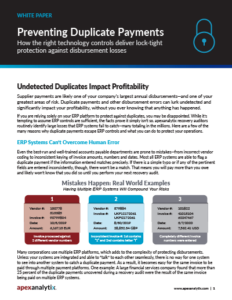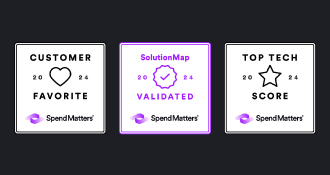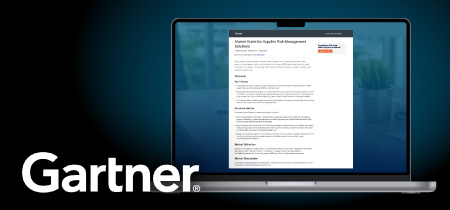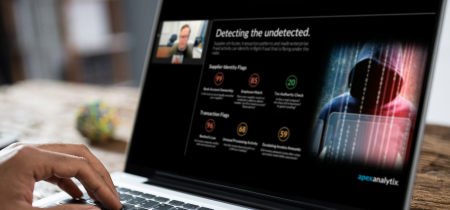
Undetected Duplicates Impact Profitability
Supplier payments are likely one of your company’s largest annual disbursements – and one of your greatest areas of risk. Duplicate payments and other disbursement errors can lurk undetected and significantly impact your profitability, without you ever knowing that anything has happened.
If you are relying solely on your ERP platform to protect against duplicates, you may be disappointed. While it’s tempting to assume ERP controls are sufficient, the facts prove it simply isn’t so. apexanalytix recovery auditors routinely identify large losses that ERP systems fail to catch – many totaling in the millions. Here are a few of the many reasons why duplicate payments escape ERP controls and what you can do to protect your operations.
Sign up to receive Analyst Reports, Webinars & more Procure-to-Pay Content
ERP Systems Can’t Overcome Human Error
Even the best-run and well-trained accounts payable departments are prone to mistakes—from incorrect vendor coding to inconsistent keying of invoice amounts, numbers and dates. Most all ERP systems are able to flag a duplicate payment if the information entered matches precisely. If there is a simple typo or if any of the pertinent fields are entered inconsistently, though, there won’t be a match. That means you will pay more than you owe and likely won’t know that you did so until you perform your next recovery audit.
Many corporations use multiple ERP platforms, which adds to the complexity of protecting disbursements. Unless your systems are integrated and able to “talk” to each other seamlessly, there is no way for one system to see into another system to catch a duplicate payment. As a result, it becomes easy for the same invoice to be paid through multiple payment platforms. One example: A large financial services company found that more than 25 percent of the duplicate payments uncovered during a recovery audit were the result of the same invoice being paid on multiple ERP systems.
Duplicates Can Soar During Times of Change
Are you in the middle of a merger or an acquisition? Reorganizing your accounts payable or shared services team? Transitioning to a single, consolidated ERP platform? Times of change can be perilous for disbursement teams. Confusion can crop up about where invoices will be paid as changes are made—causing a spike in duplicate payments and other costly errors.
The losses can quickly add up. After a merger, one of the largest banks in the US decided to eliminate a legacy system and move to a single instance of SAP. During the transition, invoices were inadvertently paid on both the old system and the new, resulting in hundreds of thousands of dollars in duplicate payments. The losses weren’t uncovered until a post-transition audit was conducted.
A global entertainment company setting up a shared services organization had the same experience. More than 250 duplicates totaling more than £640,000 in lost revenues occurred when payments were made both at the division level and by the new shared services team.
ERP Controls Can Slow Productivity
ERP solutions excel at routine, predictable tasks. When it comes to detecting duplicate payments, though, the automated controls ERP systems offer can actually slow your operations and impact productivity.
If you set too many system parameters to flag potential duplication, virtually each and every entry will result in an alert. And when that happens, chances are the alerts will be ignored and overridden by members of your data entry team. If instead you select too few parameters to scan, thousands of potential duplicate payments may escape detection. It’s a tough choice to make since neither sacrificing speed nor missing duplicate payments are good for business.
Waiting for a Recovery Audit Impacts Your Bottom Line
Regular recovery audits are an established tool for any well-run accounts payable team. But when it comes to duplicate payments, these after-the-fact, historical reviews are identifying and recapturing cash that shouldn’t have been paid out in the first place. Think about the positive impact on your bottom line if you had a way to automatically identify and prevent costly duplicate payments across multiple ERP platforms globally. What would that mean to your cash flow and your profitability?
The Solution: Duplicate Payment Software
Fortunately there is a way that you can shore up your ERP investment and proactively protect your operations from costly losses instead of waiting for a recovery audit. Industry leaders are adopting purpose-built software that can flag potential problems and give you the information you need to intervene before duplicate disbursements are ever made.
Duplicate Payment Software communicatse with your payment systems to monitor invoices, disbursements and changes to your vendor master file. Daily data feeds are extracted for analysis, so nothing happens to impede data entry or to otherwise slow your operations.
Top solutions rely on delimited data files that any ERP system can generate, so no costly integration is required. You can consolidate and analyze all data from any system, anywhere in the world, spanning different languages and currency types. As a result, you have a framework for comprehensive, global payment controls that can span multiple countries, businesses and subsidiaries.
Powerful software analytics quickly compare a comprehensive range of vendor and invoice attributes to protect you from disbursement errors. You get a single, concise report that rank orders potential issues and provides all the information you need to intervene. It takes only minutes a day.
One bonus is that the same innovative tools can be used by your team to audit historical payments—helping you identify duplicates, missed cash discounts, paid credit memos, pricing problems, tax and currency issues, compliance with contract terms and even wrong units of measure in purchase orders.
Evaluating Duplicate Payment Prevention Software
If you are ready to protect your disbursements with duplicate payment software, insist on a solution that can deliver these “must have” capabilities:
1. Consolidates and analyzes data from multiple payment platforms, including incompatible ERP systems and homegrown legacy applications.
2. Provides a comprehensive library of audit-tested duplicate payment filters.
3. Produces results in minutes so you can take quick action before disbursements are made.
4. Analyzes large global data files containing multiple years of historical transactions.
5. Includes workbench tools you can use to generate claims, attach relevant documents and build a strong audit trail.
6. Operates simply and intuitively so any member of your team can use it.
7. Provides online access so there is no need to install software on each user’s PC.
8. Displays metrics and reports in a convenient, easy-to-understand dashboard format.
9. Isolates the root causes of errors so you can determine how to tighten global controls.
10. Produces a wide range of reports to help you make better-informed decisions.
11. Protects and extends your investment by offering fraud detection, supplier information management and other fully integrated procure-to-pay tools.
To Find Out More
If you would like to know more about best practices-based software that can reduce your risk of duplicate payments, contact apexanalytix at +1 800-284-4522.
About the Author
Michele Arndt is the Executive Manager of Global Software Consulting at apexanalytix with extensive experience in accounts payable, post-audit services and software for imaging and audit. She is former director of document management and client services and a former director of accounts payable for a large retailer. Michele is a founding member of the IAPP board, has been a contributor to Paytech, and is active in the Institute of Financial Operations.






